With gondola rides along its canals, breathtaking architectural wonders, places where it’s not uncommon to see a celebrity, and festivals and biennials that bring together countless art lovers, Venice is a truly unique and captivatingly beautiful place to visit. We’re exploring the most beautiful spots in Venice, the city of fairy tales!
Situated on the Adriatic Sea in northeastern Italy, Venice is a city unlike any other in the world, making you lose track of time as you wander its streets and canals. With its towering buildings, narrow streets, and colorful bridges connecting more than 100 small islands, this memorable city is also a wonderful place to discover traces of history and art.
- Things to Know About Venice
- A Brief History of Venice
- Italian and Venetian
- How to Get to Venice?
- When to Go to Venice?
- Hotel Recommendations in Venice
- What to Eat in Venice?
- Restaurant Recommendations in Venice
- Places to See in Venice
- Venice Carnival
- Venice Biennale
Things to Know About Venice
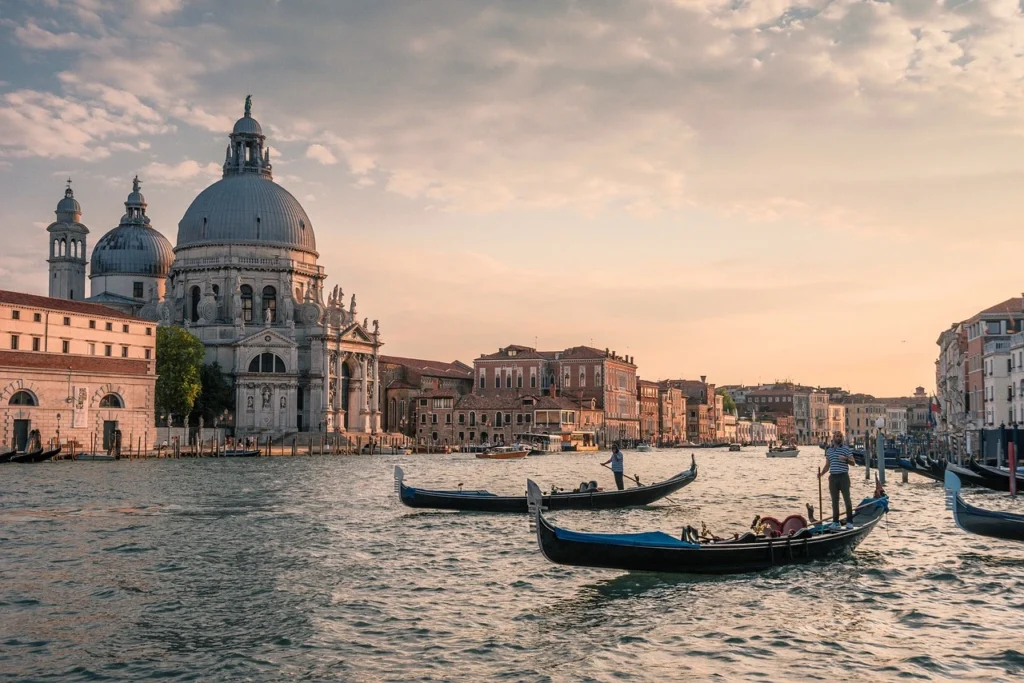
Venice may be the city most written about, mentioned in magazines, and constantly in the news! It’s also featured in countless blogs and travelogues, and the most classic Venice routes have been mapped out. I have no objections; it’s not wrong, but it’s a bit incomplete! So, let’s briefly recall how Venice came to be.
A Brief History of Venice
Venice, a city-state composed of islands that strove to dominate the Mediterranean between the 7th and 18th centuries as ” La Serenissima Repubblica “ (The Most Peaceful Republic), was a city-state striving to expand trade and enrich its people, becoming a center for art, commerce, culture, and entertainment. To this end, it engaged in warfare and, at times, forged friendly relations with the Ottoman Empire, which shared similar ambitions. It remains one of the most popular tourist destinations today.
It built its appeal over the centuries by hosting traders, ambassadors, and travelers from a wide variety of nations, while also sending ambassadors from its own people to diverse countries and cultures. While serving as a trade bridge between East and West, it also placed great emphasis on the arts. First, through Roman, then Byzantine, and through the dominant culture and architecture of the Gothic, Renaissance, and Baroque periods, it also established close ties with Istanbul, becoming a cosmopolitan center with its own unique eclectic architecture and culture.
Geographically, Venice is the capital of Italy’s Veneto region. If you picture Italy as a long boot on a world map, it’s located behind your kneecap—in other words, in northeastern Italy—a lagoon, home to the Po and Piave Rivers, which flow into the Adriatic Sea. It’s actually a largely swampy lake. While there’s still some disagreement, it’s estimated to have approximately 118 islands, 170 canals, and 417 bridges. Of these, 300 are made of stone, 60 of iron, and 57 of wood. Approximately 72 of these bridges are privately owned.
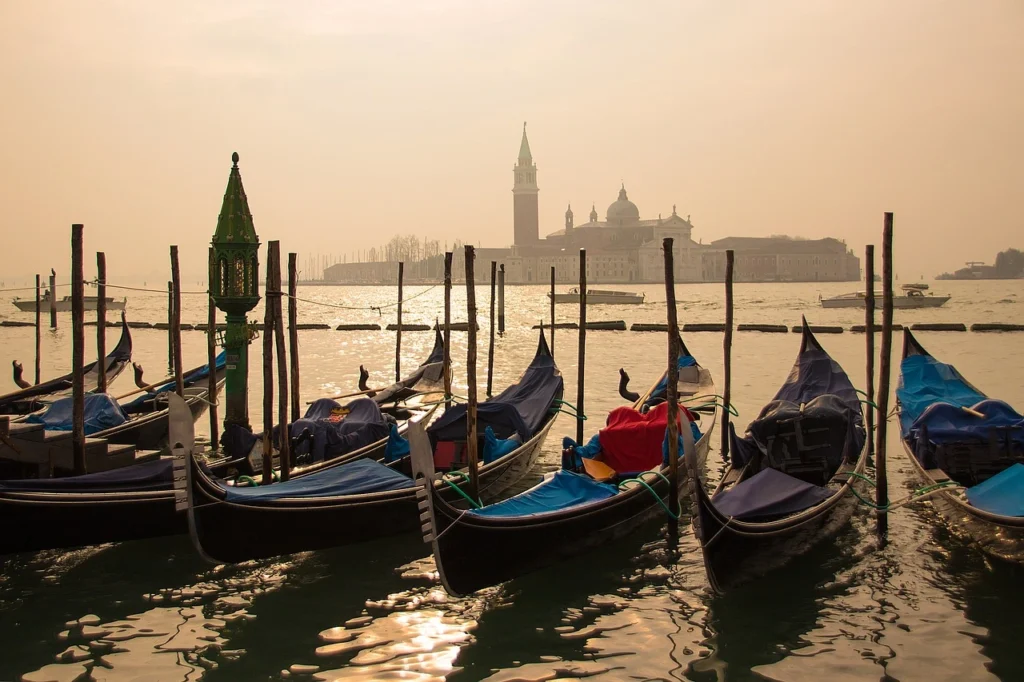
Henry James, who admired Venice, lived for a time in various parts of the city and wrote books about it. Described Venice as an apartment building of corridors and halls. I agree with him. They closed off many of the canals, so to speak, to create wider corridors and halls for themselves.
Italian and Venetian
Venezia is the city’s name in its own language. Like other historic city-states and regions of Italy, Venice has its own dialect. In fact, it’s such a unique city that, like many of its details, even its architecture has developed its own Venetian jargon. For example:
Calle-Calletta (Kalle-kalletta)
Calle in Venetian means via in Italian. Its Turkish equivalent is “street”! Some are natural, existing on small islands; others are created by filling in canals ( rioterra ). Are there any Italian ones? Yes, just like piazzas, they’re rare! Strada, meaning street, is also unique. Strada Nova (Italian: nuova), on the other hand, is not a natural, but a filled-in canal. There are only two vias: Via 22 Marzo in the San Marco district, home to the luxury shops, and Via Garibaldi in the Castello district. Calletta, meaning narrowest street, is 53 cm wide.
There’s also a salizade, which is also a street! If you ask, “Well, wasn’t that a calle ?”, there’s a difference: long ago, when all the streets were dirt, the word “salizada” (singular in this case) meaning “sandstone” was used. Later, when stone was brought in from abroad and the roads were asphalted, this change became necessary! “Don’t pass by the roads you pass by as calle, for they are asphalt ( salizada ) themselves,” they added. The ones they changed out of laziness are still called “salizade”; the ones they fell victim to laziness are still called “calle.” In other words, a calle can be wide or narrow, can open into a square or a small square; but if two streets intersect, its name suddenly becomes “crosere .”
Fontego
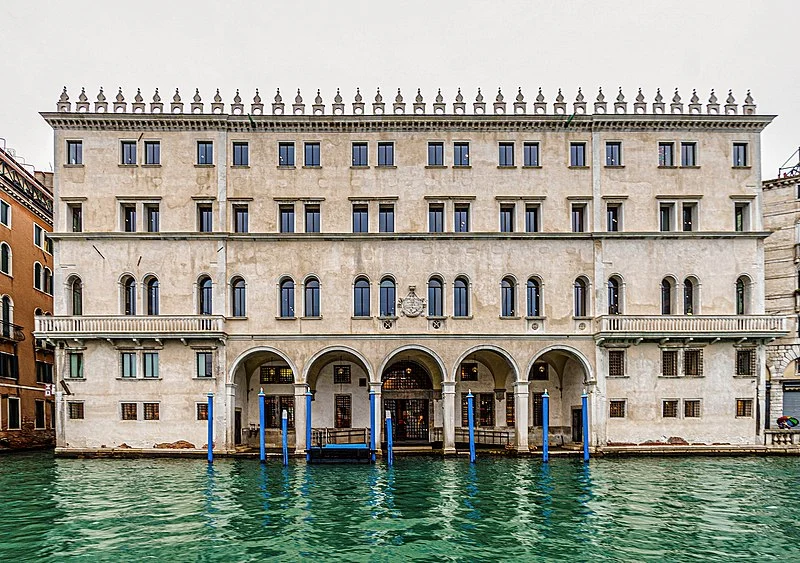
The name comes from the Arabic word “funduq,” meaning “han” in Turkish. The Italian word is fondaco. Two of them are very famous: Fontego dei Turchi (Turkish Inn; once a residence for Ottomans and Turks, now a museum of nature and architecture), and Fontego dei Tedeschi. Right overlooking the Rialto, you absolutely must visit Fontego dei Tedeschi! Currently, it’s the city’s only shopping mall with a luxury collection. There’s also a delightful café and restaurant on the lower floor. On the upper floor, there’s a terrace, the largest in the city, with free admission, from which you can see Venice from above.
Campo
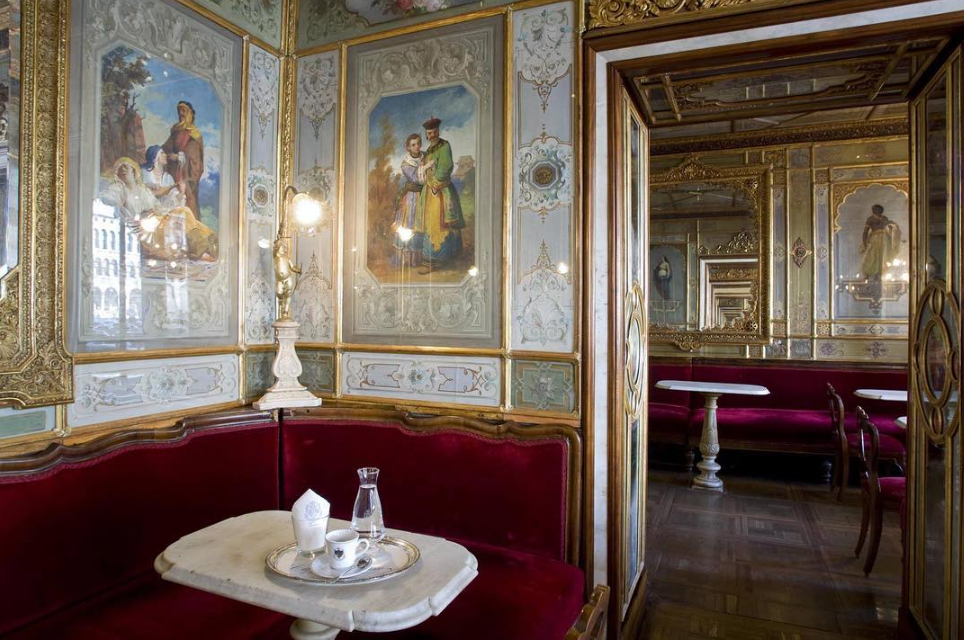
The Italian word for piazza is “square,” but in Venice, it’s called campo. There’s only one “piazza”—San Marco, the largest square! Napoleon Bonaparte beautifully described St. Mark’s Square as, ” It’s the most beautiful dance floor in the world, and only the blue sky is worthy of being its roof .” The jewel of the square is Caffe Florian, Italy’s oldest cafe, which has been hosting the world’s most famous and important guests since 1720. In this delightful venue, you can indulge in a coffee or a glass of prosecco while listening to music . Depending on the season and the sun, Gran Caffe Quadri, just across from Caffe Florian, should also be on your lunch list! This historic cafe has hosted many celebrities, from Stendhal to Woody Allen, Wagner to Proust, since 1775.
Rialto
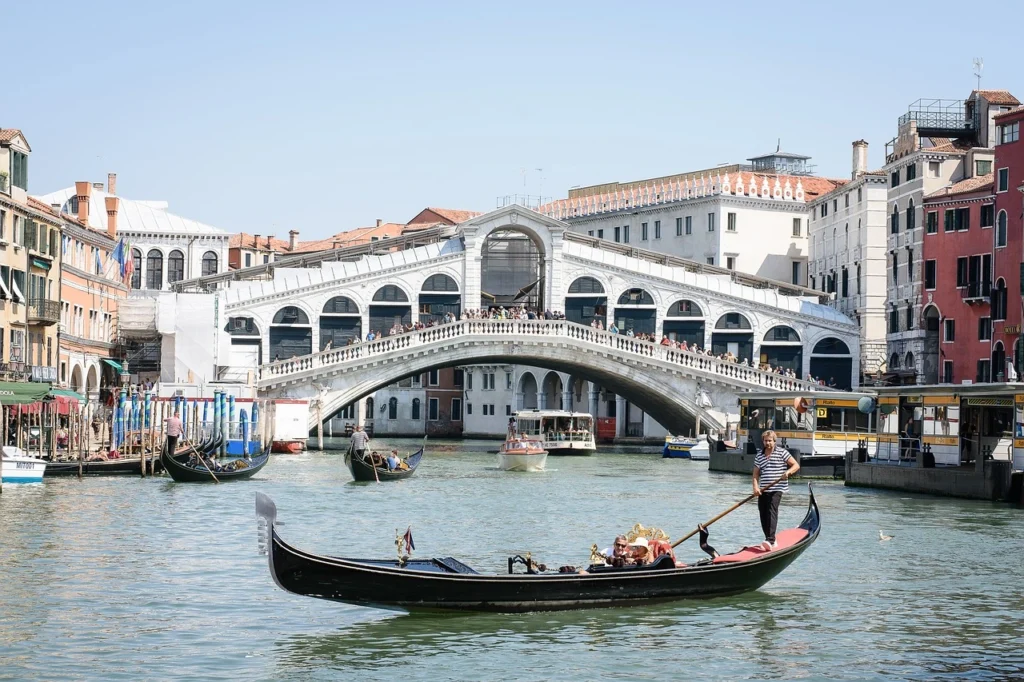
The Rialto, also known as the “Grand Canal,” has four major bridges over the Grand Canal. While Venice was a city-state, no other bridges were permitted to be built besides the Rialto Bridge. Instead, a traghetto bridge was used, and several stops on it are still in use. This means that crossing the canal by gondola takes between 6 and 10 people, depending on the situation. After a pleasant break at the Rialto or Gritti, you can also take a stop at the Accademia Bridge, which is also a short distance from the city’s most beautiful art trails.
Nissioetti
Street sign. Usually, a small rectangle is written in black marker on a white sheet of mortar.
Ruga or Rughetta
Think of it like a Calle, but with houses on one side and shops on the other.
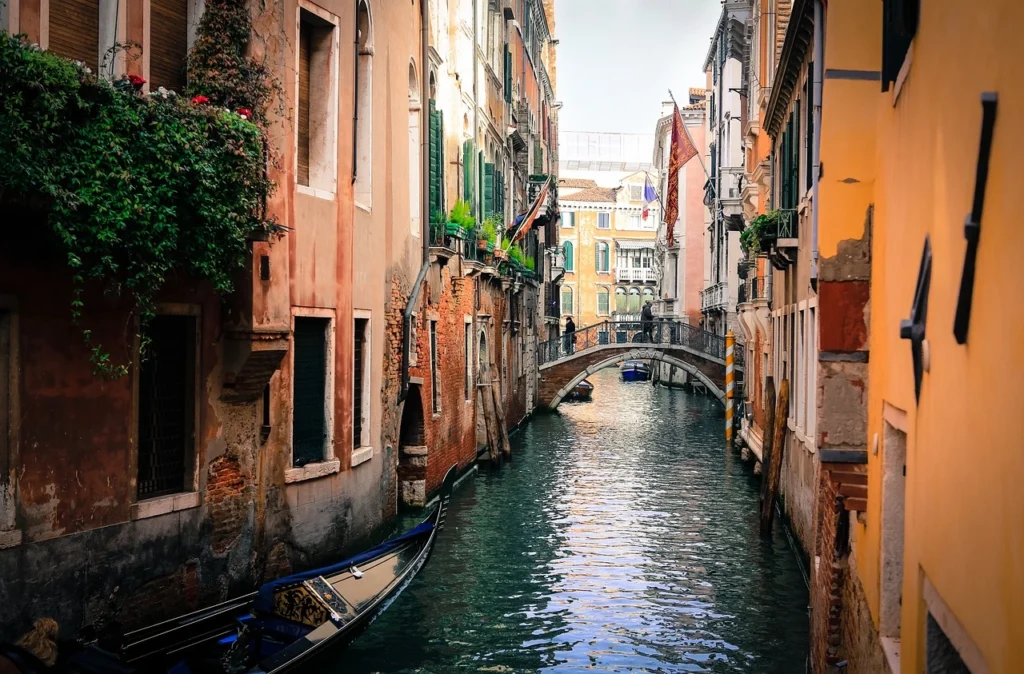
Sotoportego
They are angular tunnels between houses.
Masegni (Mazenyi)
Italian writer and engineer Paolo Barbaro once said, “ Everything you see in Venice has been brought, imported, smuggled in, or looted. ” How beautifully put! This city, comprised of a lagoon and a former swamp, was adorned with precious statues and stones brought from the Balkans, the Greek islands, and—most valuable of all—from Istanbul during the Fourth Crusade of 1204. In short, masegni, a type of stone in the Venetian dialect, were also brought from abroad because the city was short of stones.
How to Get to Venice?
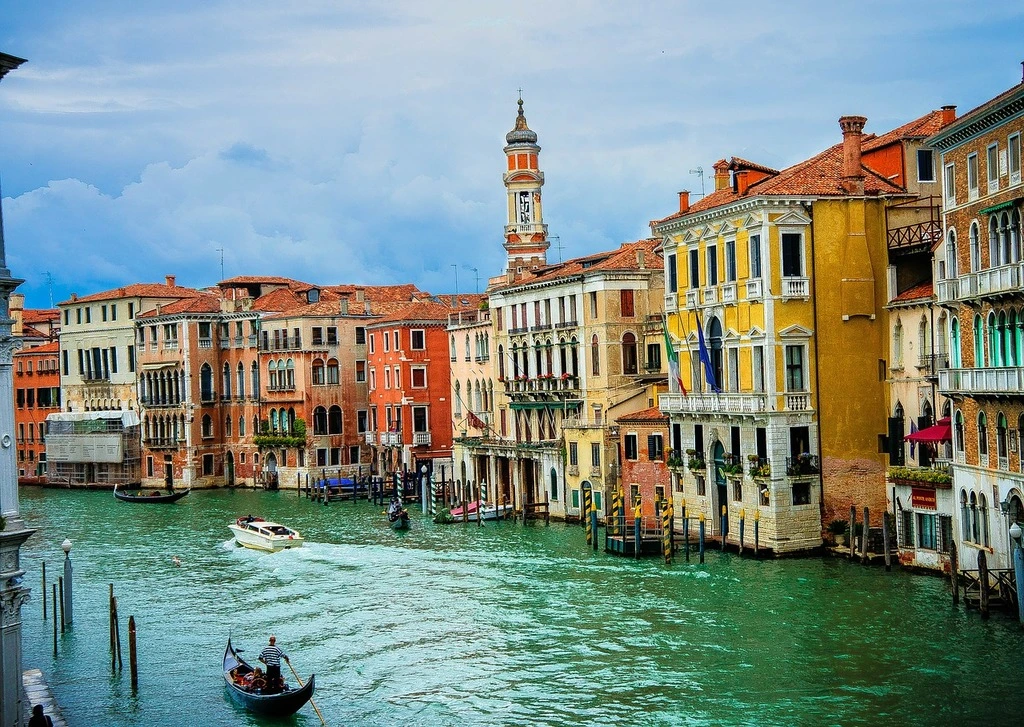
Venice is a city of islands, connected to the mainland by the Ponte della Libertà, or “Liberty Bridge.” Therefore, it has both water and land routes. There are paid parking areas in Piazzale Roma and Tronchetto, where the land route ends. From there, you can directly reach your destination by boat or water taxi. It has a very busy airport. You can reach the city from the airport by water or land in approximately 25 minutes by water taxi. The route and vehicle selection can be made depending on your accommodation.
There are direct flights from almost anywhere in the world. It’s about a 2-hour, 20-minute flight from Istanbul. There are high-speed trains from Milan every half hour, taking about 2.5 hours. If you’re planning a trip to Venice, don’t forget to book your flight now!
If you want to make transportation in Venice easier, you can use public transportation and airport transfers with a Vaporetto Pas, take a pleasant water taxi ride from the city center to Marco Polo Airport, or reach the airport quickly and comfortably by one-way bus.
When to Go to Venice?
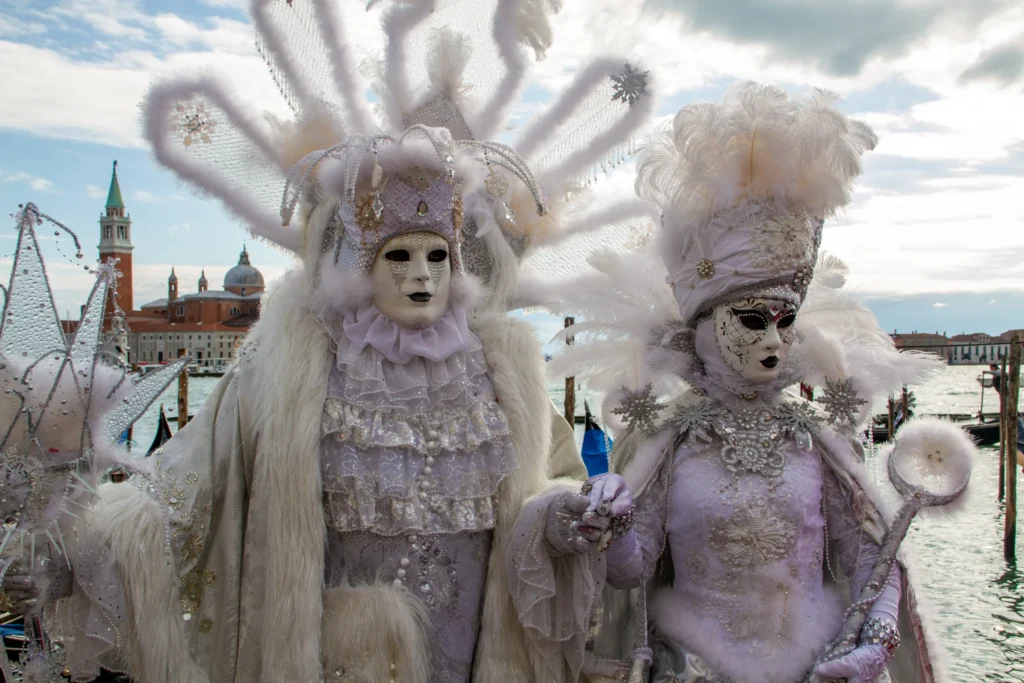
When it comes to Venice, the date you visit is more important than the season! Times like the opening week of the Venice Biennale at the end of April, the week of February coinciding with the Venice Carnival, and the Venice Film Festival in early September are when the city is at its busiest.
The city’s population also swells during the week of the Regata Storica (rowing races) and during Redentore, the city’s most important holiday, which falls in July . If you’re planning to visit for these events, it’s best to make reservations well in advance. This applies not only to accommodations but also to restaurants.
The most enjoyable months to visit Venice are generally April, May, and October, when the weather is mild, the days are dry, and the exhibitions are plentiful. If you’d rather visit the city when the tourist crowds are at their lowest, with its unique architecture, tranquility, and captivating reflections under the mist, December, January, and March are also ideal.
Hotel Recommendations in Venice
The Gritti Palace
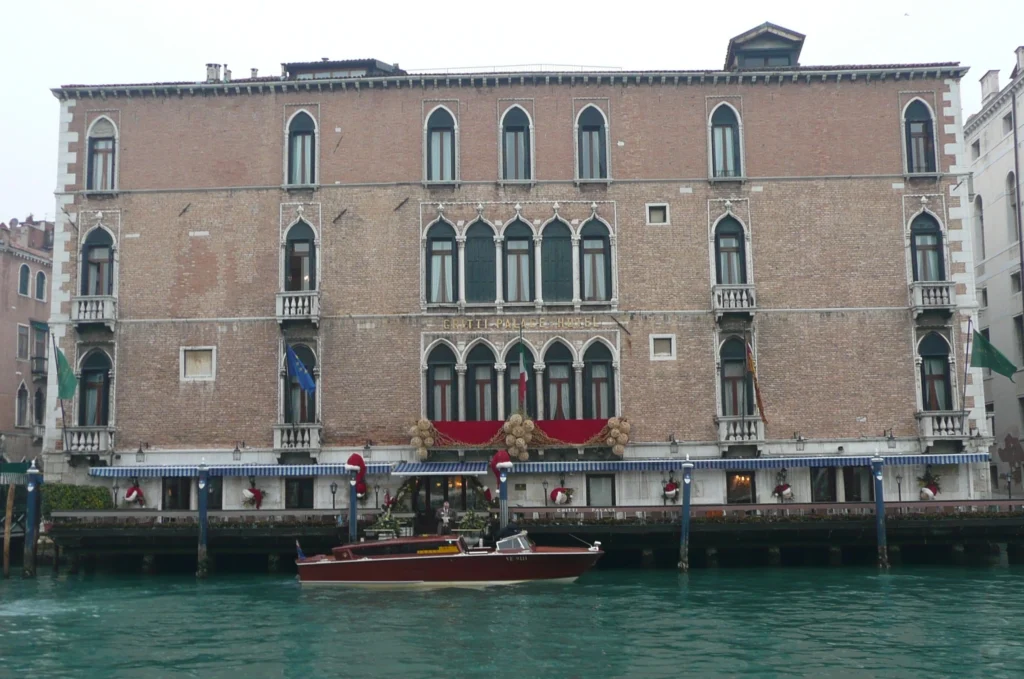

Right in the middle of luxury shopping, after the Bauer Hotel underwent renovations, The St. Regis Venice is now the city’s favorite hotel! The suites are magnificent, and the canalside breakfast and bar lounge are incredibly enjoyable.
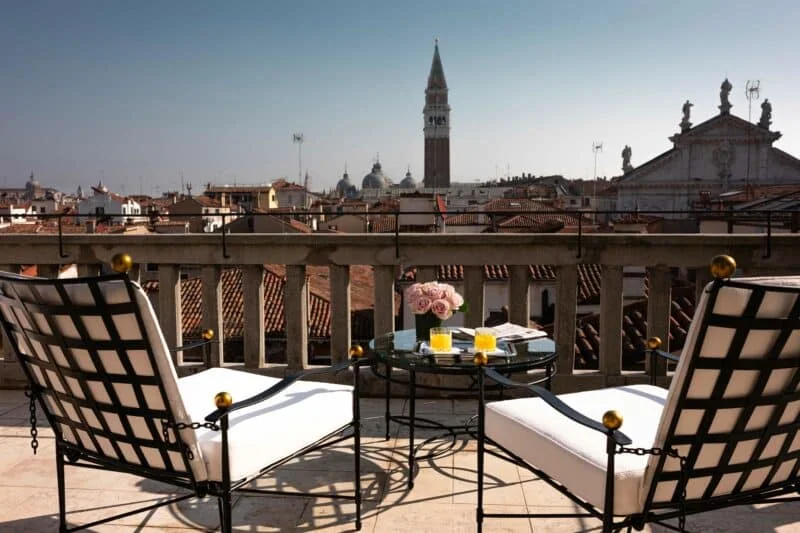
Almost opposite The St. Regis Venice, but not on the canal and only 2 minutes from St. Mark’s Square, is the city’s newest and most beautiful luxury hotel, Nolinski.
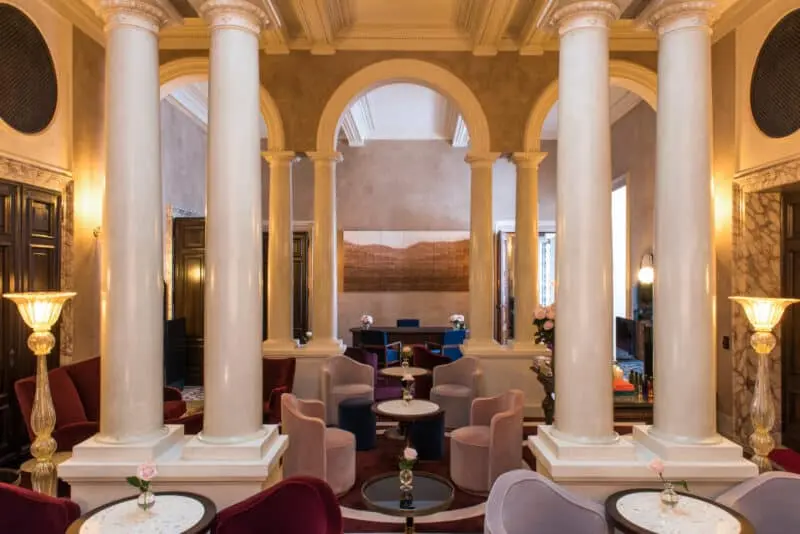
Ca’di Dio
Ca’d i Dio is one of the city’s newest five-star hotels. A simple yet refined hotel, renowned for its historical significance and ideally located for biennial-focused visitors.
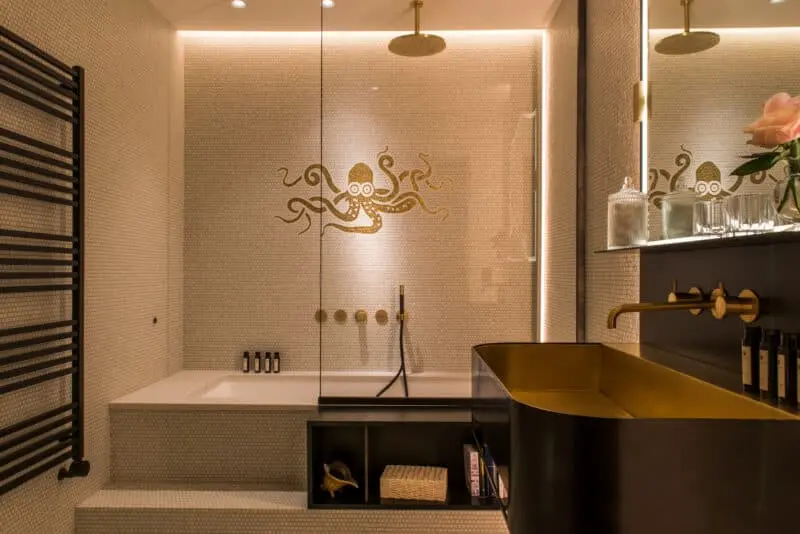
Starhotels Splendid
The 4-star Starhotels Splendid is a nice, clean hotel that doesn’t strain your budget, with its convenient location between Rialto and San Marco Square.
What to Eat in Venice?
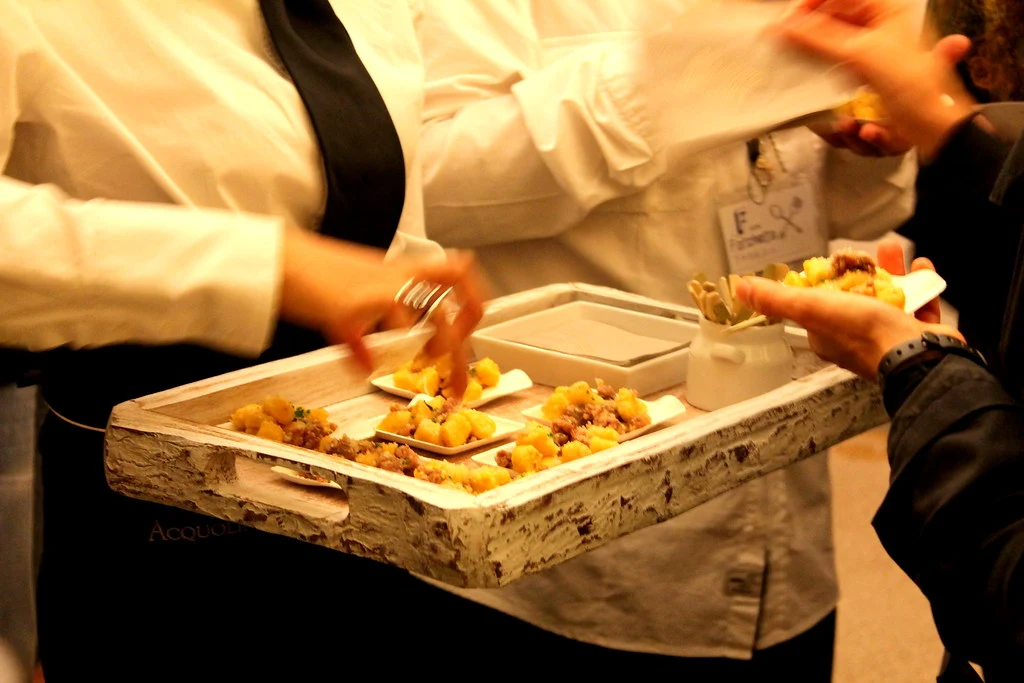
Venice’s glorious and diverse history is reflected in its cuisine. While fish is a dominant feature, they also do a great job with meat and pastries.
First, it’s worth mentioning the lesser-known cicchetti, similar to Spain’s tapas. You can usually try these small, bread-based snacks alongside a drink before lunch or dinner. In Italy, small establishments serving cicchetti with drinks are called taverns or bacari. While they’re common in every region, the most special ones are found in the Rialto area, around the Accademia area in Dorsoduro, and near the Fondamenta de la Misericordia in the Cannaregio district.
If you want to have delicious experiences while exploring Venice, there are many options:
- You can experience the flavors of the city by joining a guided street food tour
- You can take a catamaran tour in the Venice Lagoon and enjoy a Spritz.
- You can discover the hidden flavors of the city by tasting street food with a local guide
- You can have an unforgettable gastronomic experience with dinner at a Venetian-style restaurant
Restaurant Recommendations in Venice
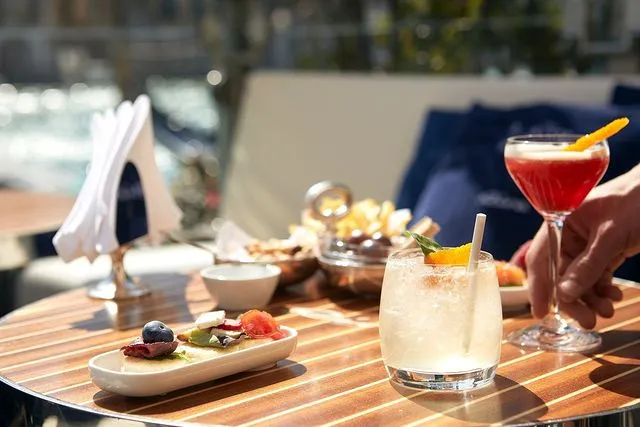
Contrary to popular belief, Venice actually has a wide variety of restaurants. The most important thing to keep in mind is reservations and, of course, the days when restaurants are closed. Because venues are small and demand is high, I highly recommend making reservations in advance, even if you’ve planned your trip months.
If you prefer fine dining and a canal view, Club Del Doge Restaurant at the Gritti Palace Hotel might be the perfect choice. If the canal and location aren’t important, but you prefer local and quiet dining, Da Fiore, far from the tourist crowds, where Mara and Maurizio Martin serve classic Italian dishes with seasonal fruits and vegetables in a lighter, more modern style, and L’osteria Santa Marina near the Rialto might please you.
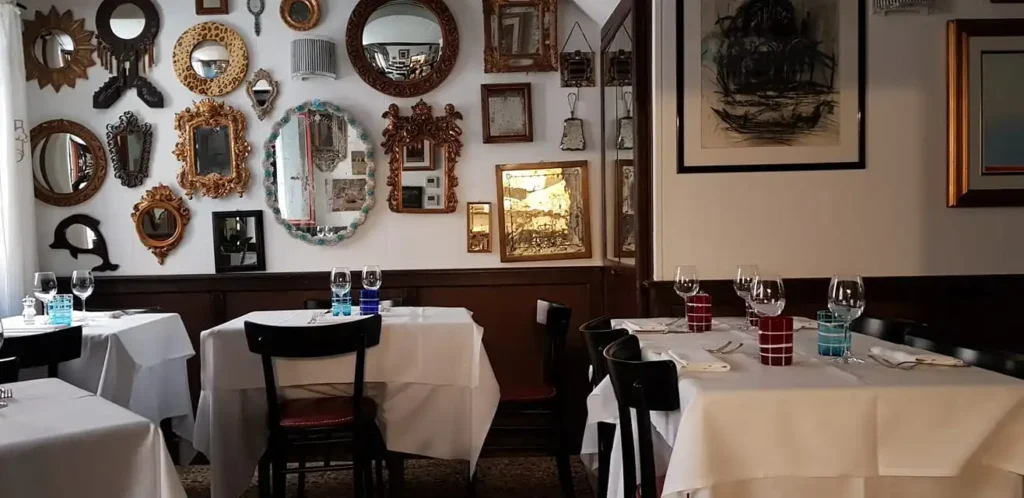
For delicious local seafood, you should try Trattoria Antiche Carampane, a family-run restaurant in the Rialto district and a favorite of many Hollywood stars. I also recommend having a pleasant conversation with Francesco, one of the restaurant’s owners, about this charming little spot and Istanbul.
You’ll also be delighted by the tiny Osteria alle Testiere, a restaurant with just nine tables and a daily menu featuring fresh fish and produce, tucked away in a convenient spot near San M. co. Don’t be surprised to see all nine tables filled with world-renowned stars and artists during the biennial’s opening weekend and the film festival.
Al Covo Restaurant, a family-run restaurant close to the Arsenal (Venice Shipyard), is another place you can stop by to try local delicacies.
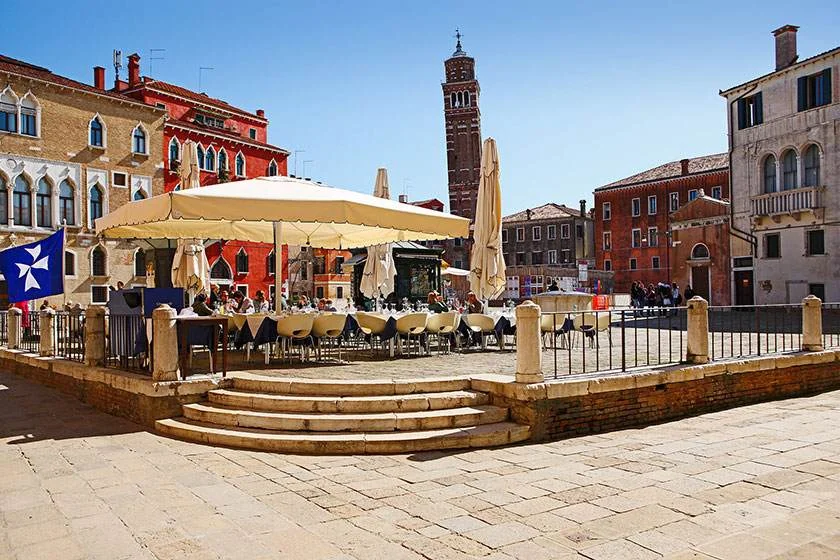
If you’re thinking, ” Fish is fine, but I’d like some pizza or pasta, and I’d like to sit in a quiet square and enjoy my meal while taking in the view of the surroundings and the people passing by, ” I recommend Ristorante AcquaPazza, a family-run restaurant just a few minutes’ walk from San Marco, whose menu features ingredients from Amalfi, a place deeply rooted in its roots, even though they live in Venice.
If you’ve already eaten at these places and are looking for a different gourmet restaurant, then Ristorante Wisteria Dama or Bistrot de Venise might be on your list.
If you’re looking for a Michelin-starred and exclusive restaurant, Ristorante Venissa in Mazzorbo, connected by a bridge to the island of Burano, famous for its colorful houses, should be among your options. It’s a delightful restaurant nestled in the island’s lush greenery and boasts its own small vineyard.
Places to See in Venice
St. Mark’s Basilica
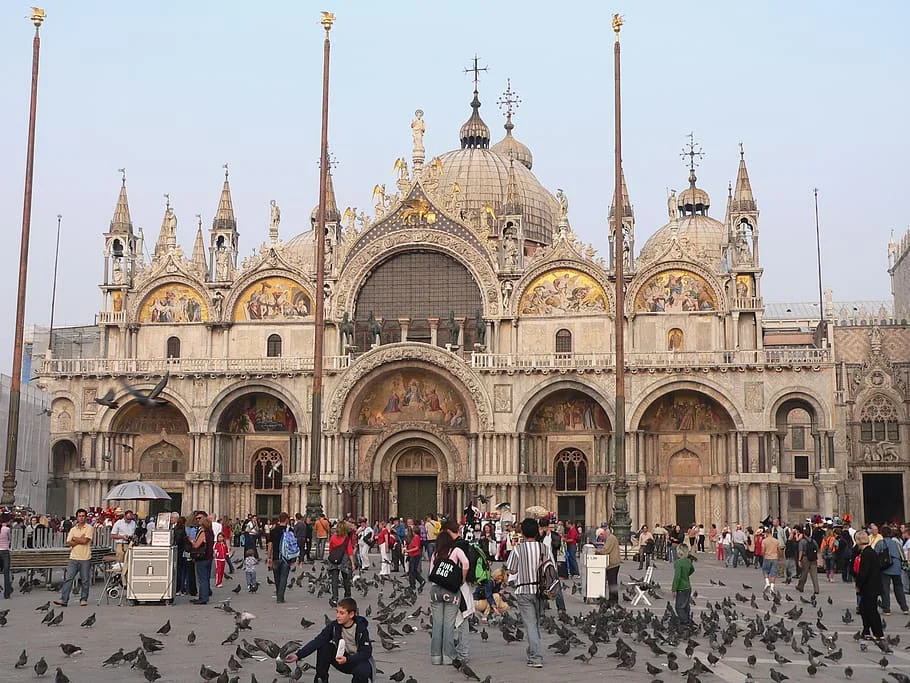
St. Mark’s Basilica is to Istanbul what Hagia Sophia is to Istanbul. While it’s a place of worship, it’s also a truly significant historical site worth discussing for hours! Don’t let the long line at this church, which houses the sacred relics of St. Mark, one of the four evangelists, deter you; it’s definitely on your list!
When you visit, don’t leave without seeing the Pala d’Oro (Golden Altar) behind the Altar, made by artists in Istanbul in 976 and adorned with around 2,000 incredible precious stones, and the originals of the four bronze horses brought from Istanbul’s At Meydanı during the 4th Crusade in 1204.
Don’t leave without taking in the wonderful view of the square from the terrace. There’s an entrance fee to the church. If there’s a long queue, you can skip the line for a few euros.
If you want to experience history and art while exploring Venice:
- With St. Mark’s Basilica priority entrance tickets, you can see this iconic structure without waiting in long lines.
- By taking a guided tour of St. Mark’s Basilica, you can explore the history and details of the building more closely.
- Thanks to guided tours, you can learn the history and architecture of both the Basilica and the Doge’s Palace in detail.
- With the Venice Pass, you can visit other important points of the city at a discount.
Palazzo Ducale (Dog’s Palace)

The palace, home to the Doge (also known as “doj, doce, duka, duk”, who ruled the Serenissima (Old Venice), right next to St. Mark’s Basilica, is filled with magnificent works of art. The Doge’s Palace, mostly built between 1309 and 1424, was built on a castle that previously stood on the site. After being severely damaged by a fire in 1574, the palace was rebuilt according to its original design, reflecting Gothic architecture. (The artist Anselm Kieffer even referred to this event, organizing a highly successful exhibition in those halls in 2022.)
If you want to experience history and art while exploring Venice:
- With a fast-track entrance ticket to the Doge’s Palace, you can visit the palace without waiting in long lines.
- Discover the secret rooms and historical details of the palace with the Secret Itinerary guided tour and priority entrance.
- With a guided tour of the Doge’s Palace, you can experience the general atmosphere and history of the palace.
- With the St. Mark’s Square Pass, you can visit the Doge’s Palace and other important buildings with a single ticket.
Don’t leave without examining the statues of the gods Mars and Neptune on the Giants’ Staircase (Scala dei Giganti), where the coronation ceremonies of the Doj took place; and without seeing the wood carvings and gold leaf in the rooms where the Doj lived, as well as the magnificent works of the Italian painter Jacopo Bassano’s “Jacob Returning to Canaan” and the Italian painter Veronese’s “The Abduction of Europa.”
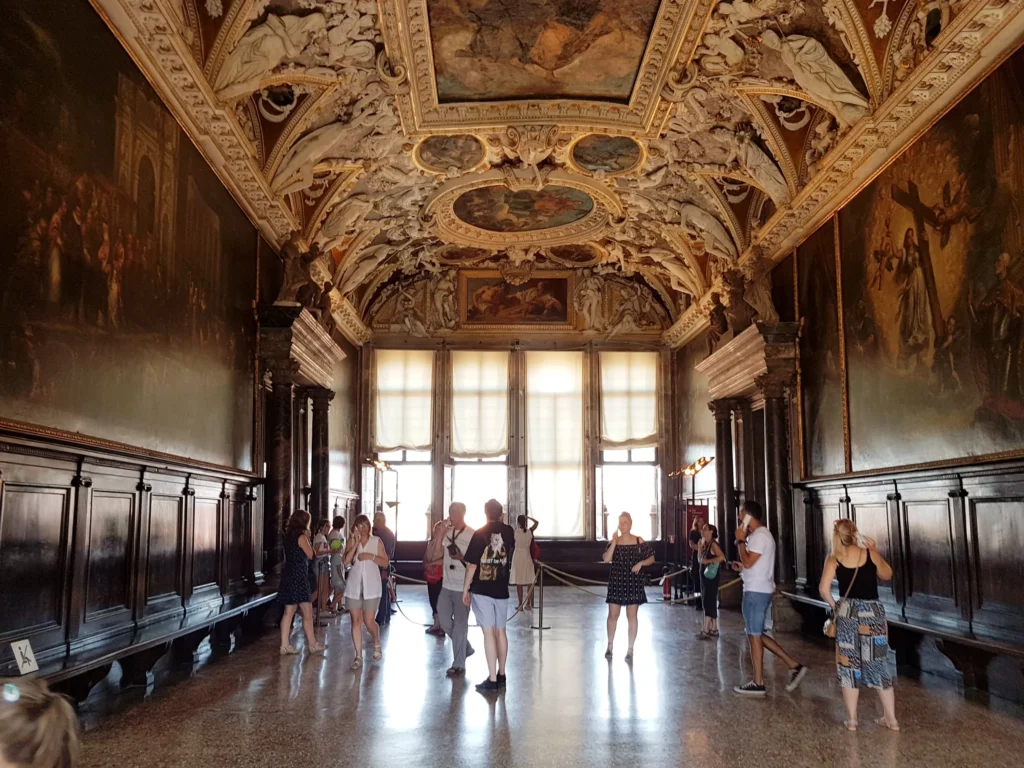
If you ascend the Scala d’Oro (Golden Staircase), you’ll enter the Four-Doored Room ( Sala delle Quattro Porte ), whose ceiling is adorned with scenes from the Bible. On the ceiling of the Grand Council Chamber ( Sala del Maggior Consiglio ) is Tintoretto’s “Paradise,” considered the world’s largest oil painting. Above the Doge’s throne is Veronese’s painting of Commander Sebastian Venier thanking Jesus for his victory at the Battle of Lepanto against the Turks. I’ve mentioned Venice’s many connections to Istanbul. Indeed, there are many traces of this in this palace. Don’t be surprised to see the Ottoman flag in the paintings!
Gallerie Dell’Accademia (Academy Gallery)
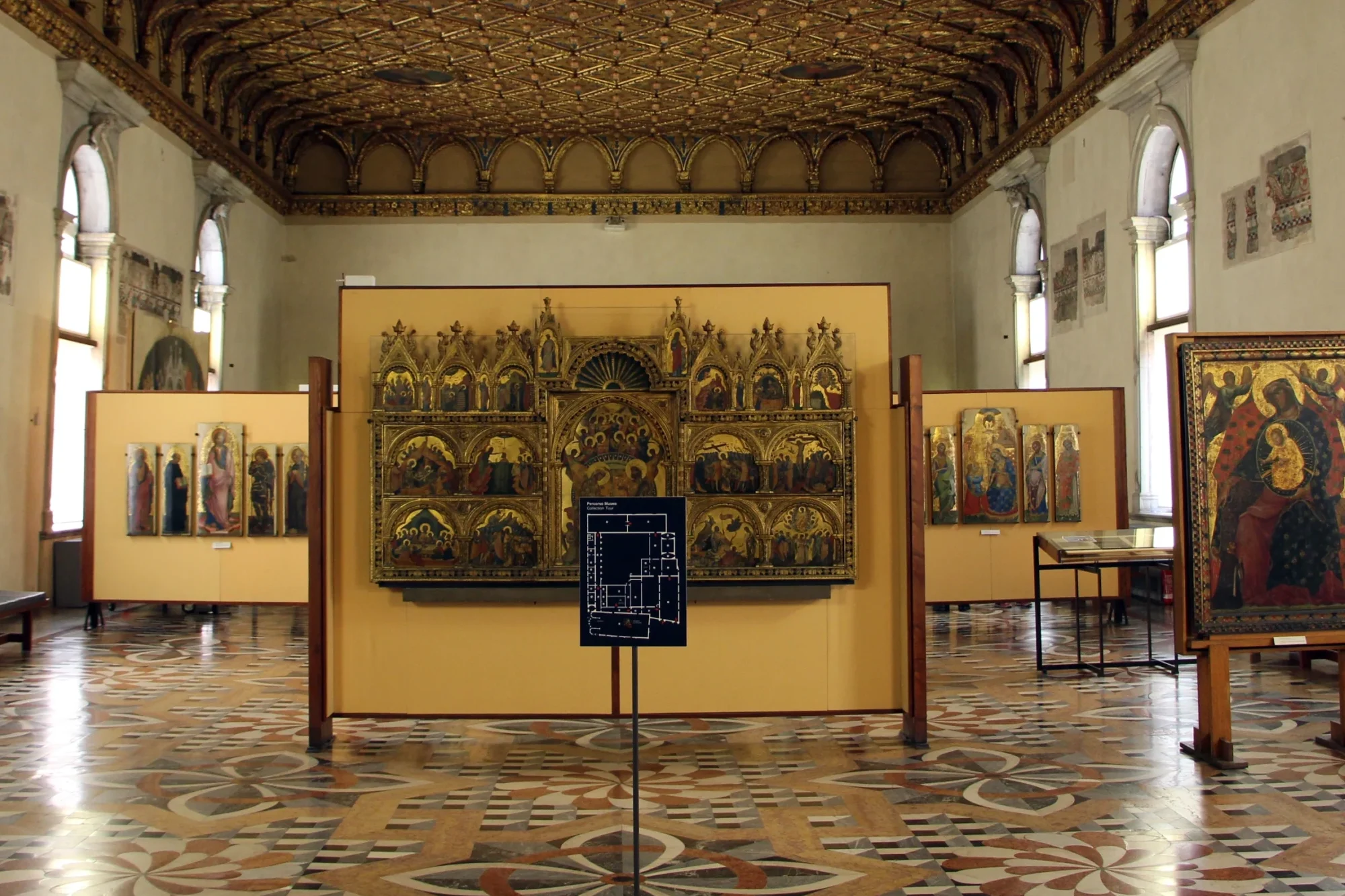
Although steeped in history, the Accademia Gallery, opened in 1750 by the Venetian Senate as the city’s school of fine arts, offered training in painting, sculpture, and architecture. Indeed, the purpose of transforming the previous structure was to transform Venice into one of Europe’s art centers. Located right at the foot of the Accademia, the second oldest of the four famous and beautiful bridges of the Grand Canal that bisects the city in the shape of an inverted S, the museum has exhibited collections open to the public since 1817. It houses works by prominent figures in Venetian art, including Giorgione, Giovanni Bellini, Vittore Carpaccio, Veronese, Tintoretto, and Titian, as well as the Dutch Renaissance painter Hieronymus Bosch and Leonardo da Vinci’s famous ” Vitruvian Man .” The Accademia Gallery now also hosts contemporary artists in conjunction with the Biennale.
Ca’ D’oro
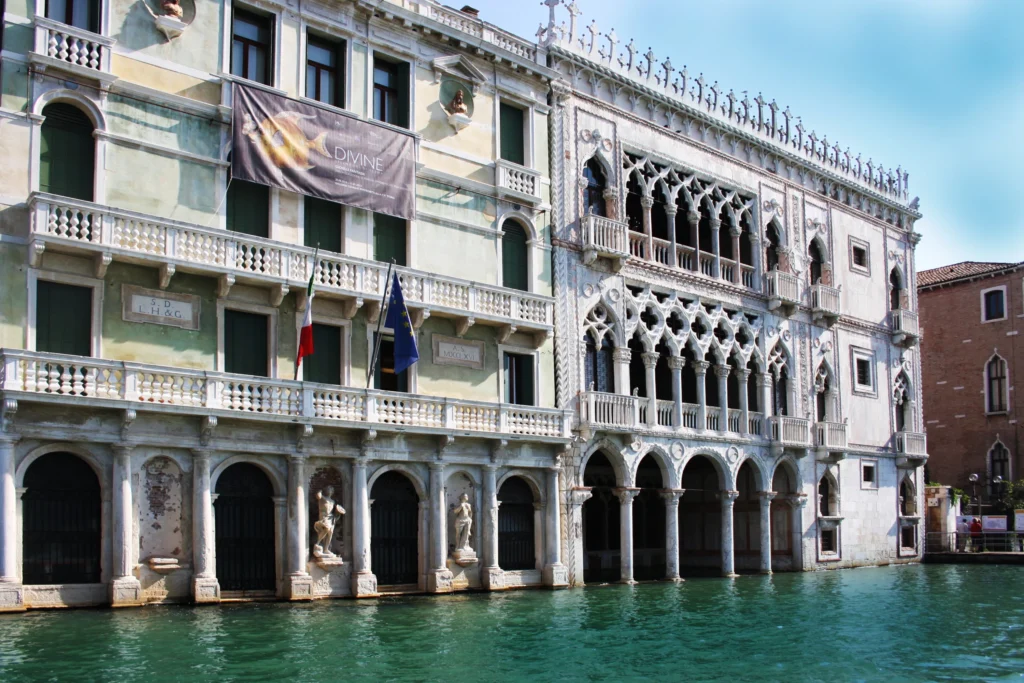
Ca’ D’oro, which translates to “golden house,” retains its name, a nod to its former glory, but for me, it always evokes the French word “j’adore ” (to be admired). That’s my interpretation, because I’m always captivated by it. With floor mosaics that rival even the most exquisite carpets, its permanent collection of works, and its temporary exhibitions, it should definitely be on your list. When you visit, I also recommend a drink on the terrace of the nearby Venice Hotel.
Scuola Grande Di San Rocco
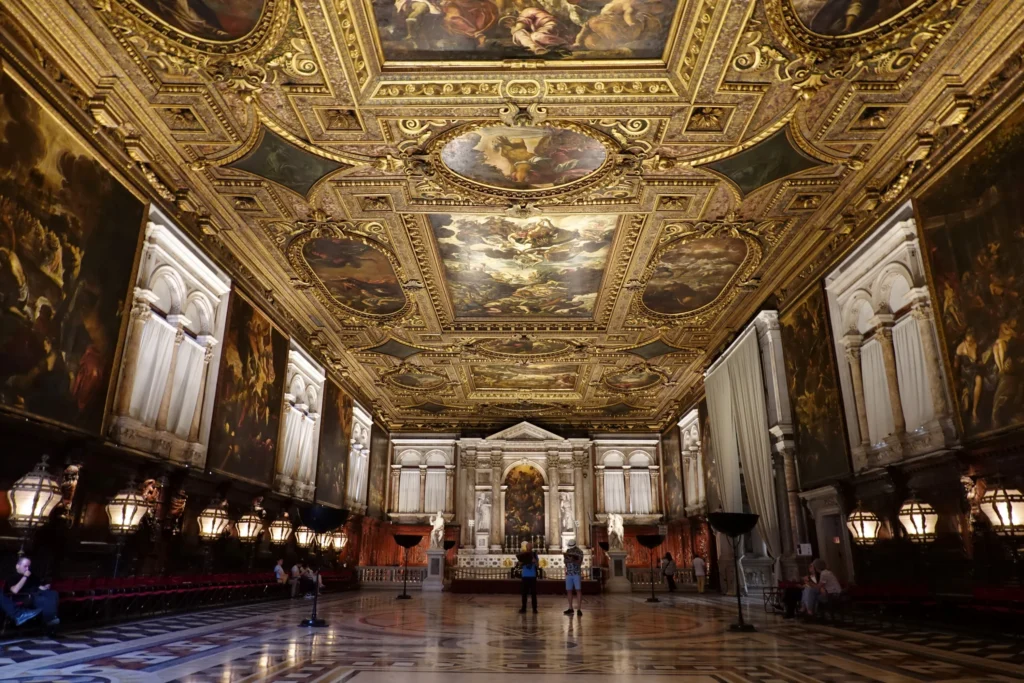
It wouldn’t be an exaggeration to call the Scuola Grande Di San Rocco, one of Venice’s most magnificent structures, Venice’s ‘Sistine Chapel’! Of the six most important schools of the period (this is a deep topic in itself; think of them as educational buildings, trefoils, and mostly secular schools that offered vocational courses and included religious education), only four are active today.
Commissioned in 1478 by Venice’s wealthy families to protect themselves from the plague, which twice engulfed the city, the building was completed in 1560. Named after St. Rocco, who fought the plague, the Scuola Grande di Rocco, which has defied the centuries, is magnificent with both its façade and its intricately decorated halls and rooms.
The renowned Italian painter Jacopo Tintoretto, who took over the building’s decorative work in 1564, dedicated 23 years to the building, painting each room individually. The walls and ceilings of the building, where you can see over 50 of his works, are adorned with beautiful paintings. Even in the film “Everyone Says I Love You,” by the Venetian-loving American director Woody Allen, Julia Roberts and Woody Allen discussed the film’s protagonist’s passion for Tintoretto.
In the last room on the upper floor, a painting titled “Crucifixion of Christ ” takes up an entire wall and is stunning. The tradition hasn’t been broken; centuries later, in 2020, when the pandemic lockdown ended, it was the first place to open, holding a kind of thanksgiving service. I was deeply moved by the years and events commemorated, alluding to history. Italians, so devoted to their roots and traditions, even in the thick of the pandemic, wore masks and joined in this prayer of thanksgiving and the opening ceremony.
Punta della Dogana (Contemporary Art Center)

A must-see for visitors to Venice interested in contemporary art, Punda Della Dogana is a very special venue hosting an exhibition running alongside the Biennale. Built between 1678 and 1682, this former customs building, situated on a triangular site separating the Grand Canal and the Giudecca Canal, was restored and converted into a gallery by renowned French art collector and businessman François Pinault. The restoration was commissioned by renowned Japanese architect Tadao Ando, winner of the Pritzker Architecture Prize, often considered the Nobel Prize in architecture.
Although this building and the Palazzo Grassi on the Grand Canal are separate institutions, you can visit both buildings with a single ticket. I recommend visiting these centers, which host important and special artists every year, along with the other magnificent structures nearby. You can follow current exhibitions on their websites. Both venues also have a small restaurant and café.
If you’d like to explore this impressive art space up close, you can purchase your entrance ticket for Punta della Dogana and explore the collections in detail with a guided tour, wander the exhibition halls at your own pace, or attend special events and curator meetings.
Peggy Guggenheim Museum
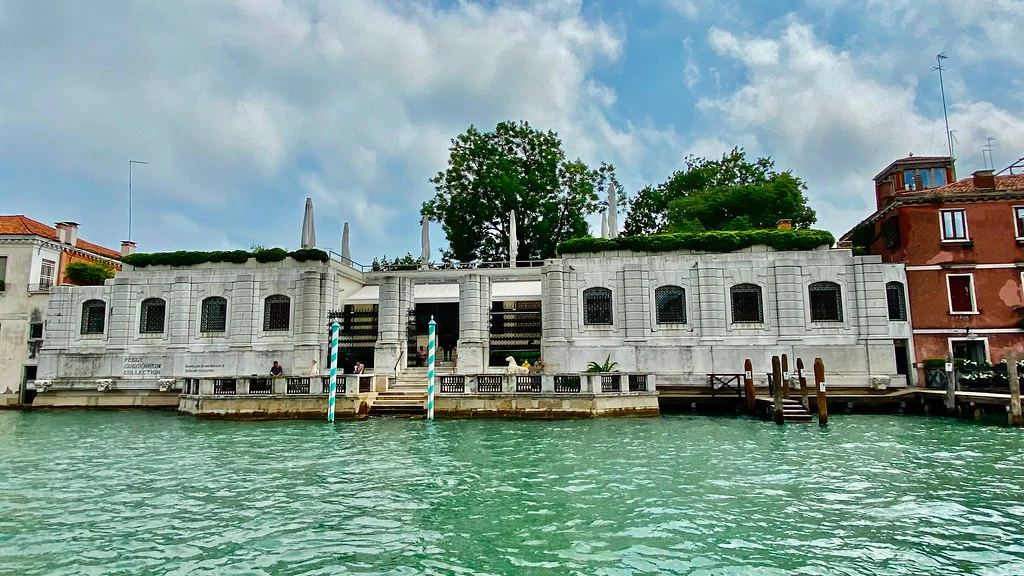
Among the renowned Guggenheim institutions currently housed in New York, Bilbao, Abu Dhabi, and Venice, home to modern and contemporary art, the Peggy Guggenheim Museum is perhaps the most unique and personal. The museum’s permanent collection, which includes works by some of the most important figures in art movements such as futurism, surrealism, and abstract expressionism, includes works by many prominent artists, including Max Ernest, Jackson Pollock, Salvador Dali, Pablo Picasso, Georges Braque, Wassily Kandinsky, and Alberto Giacometti. It also hosts temporary special exhibitions annually, such as the Marcel Duchamp Exhibition, which runs until March 2024.
If you’d like to explore this unique art collection up close, you can purchase a fast-track ticket for the Peggy Guggenheim Collection and listen to the stories behind the works on a guided tour, explore the museum at your own pace, or participate in special exhibitions and workshops.
Ghetto
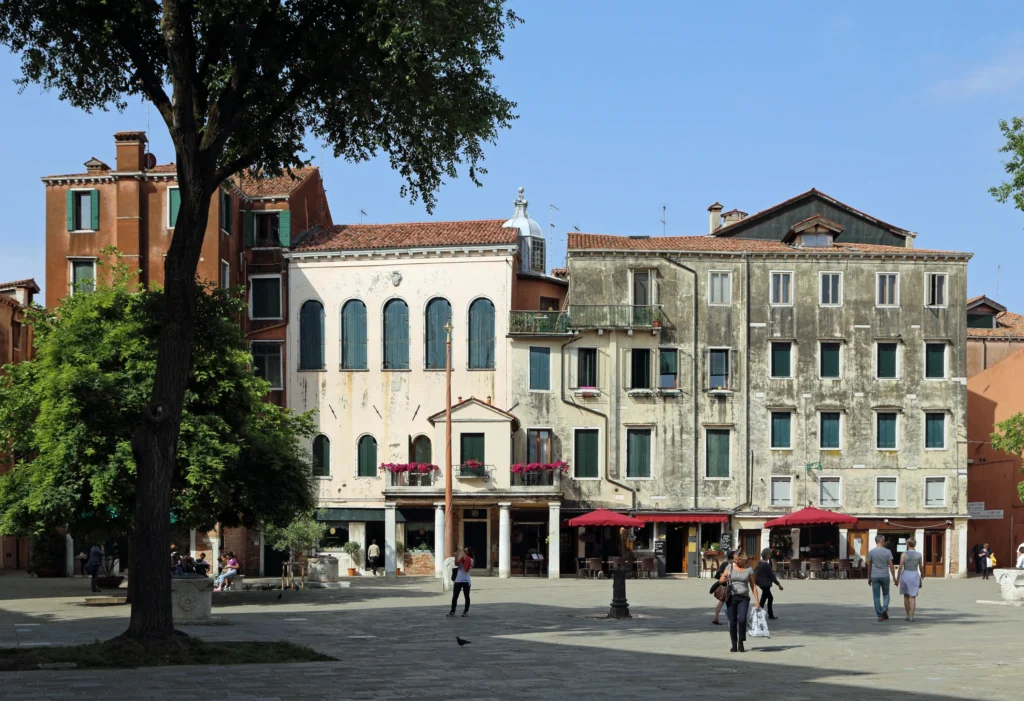
Although the Ghett, known today as an urban area characterized by the concentration of disadvantaged people or groups, actually means “foundry” in Venetian dialect. In 1516, the government allowed Jews to reside in the area furthest from the city’s political center, where the former cannon foundries were located.
The city’s oldest synagogue and kosher restaurants are also located here. Although it resurfaced in 2022 when artist Anish Kapoor opened an exhibition in the palace opposite the old ghetto and made a work referencing it, I believe it remains one of the city’s most special areas, known for its call to prayer. If you spend an afternoon here, I recommend grabbing a snack in the Cannaregio area, just off the ghetto.
Nearby is the Madonna dell’Orto, one of my favorite churches in Venice, both inside and out, and home to Tintoretto’s works and tomb . Hee tombs of four of the most important families of ancient Venice are also worth seeing, as is their architecture.
If you want to explore the history of Venice closely:
- By purchasing an entrance ticket to the Jewish Quarter and Synagogue, you can tour the area in detail with the help of a smartphone audio guide.
- With the Jewish Ghetto self-discovery tour, you can explore this historic site at your own pace using app-assisted guidance.
Venice Carnival
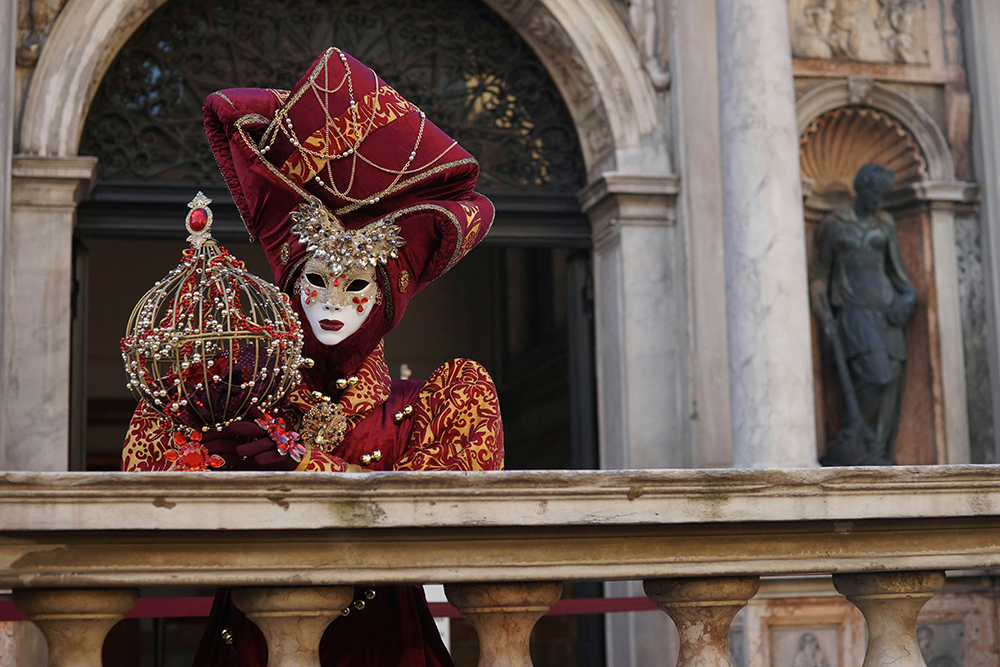
Every year, on certain days in Venice, life is decked out in masks and costumes. While the community and budgets may change, the number of visitors to the city continues to increase significantly for the Venice Carnival, one of the most beautiful carnivals that reflects the public and urban chaos.
If you want to make the Venice Carnival unforgettable:
- You can design your own mask by participating in the carnival mask-making workshop.
- You can learn the process of making traditional Venetian masks with a mask-making tour.
- Discover the city’s musical heritage with a concert of Vivaldi’s Four Seasons accompanied by Interpreti Veneziani and a visit to the Music Museum.
History of the Venice Carnival
While much has been written about the Venice Carnival, there’s no definitive date for its inception. The first document documenting this world-renowned, lavish carnival dates back to 1094, when it was administered by Duke Vitale Falier. Essentially, the Venice Carnival was a festival where the public enjoyed themselves to the fullest before Great Lent (La Quaresima).
Lent, according to Christianity (especially Catholic and Orthodox), is a type of fasting period in which one meal is eaten daily for 40 days, with the lightest foods consumed, especially on Fridays, but meat is not eaten during this period. This fast culminates in the important religious holiday of Easter.
The year 1296 marked the transition of the Venice Carnival into a public holiday when the Senate of the Republic of Venice (La Serenissima) declared the last day of the festival a holiday before Lent. From this date on, the carnival became a significant entertainment period for Venetians and foreigners alike. In fact, according to archival sources, it once began on the first Sunday of October, intensified during the Epiphany (January 6th in Italy), and peaked before Lent.
People abandoned their daily routines and reveled wildly. Acrobats and musicians gathered in the squares, playgrounds were set up, chestnut and sweet vendors strolled around, and everyone enjoyed music. With the introduction of masks, in particular, dancing took place day and night; everyone, regardless of identity, class, race, or religion, enjoyed the heights of festivities. This continued until the French, led by Napoleon, occupied the Republic of Venice in 1797.
Between 1260 and 1797, different rules were established in different years, and restrictions or changes were promulgated by law. However, as the occupying French and then the Austrians canceled the carnival events, thus preventing the Venetians from continuing their traditions and disdaining the celebrations, the carnival gradually began to lose its splendor, and for many years it was not celebrated except on Burano and a few other islands.
So how did it regain such fame? In the 1970s, a group of Venetians and several associations dedicated themselves to reviving the famous Venice Carnival for the development of Venice. They prepared a rich program for the 1979 Carnival, involving the entire public. The shows generated significant interest, and in the following years, powerful sponsors, television broadcasts, and advertising brought them back to prominence.
Gondola Experience in Venice
One of Venice’s most iconic and romantic experiences is undoubtedly a gondola ride. As you glide through the city’s canals, you can explore both historic bridges and impressive structures from the water and witness the mastery of the gondoliers. Whether you’re cruising the quiet canals of the city on a classic gondola ride and listening to Venice’s history with optional live commentary, or you can experience the city’s iconic landmarks from the water on a Bridge of Sighs and St. Mark’s Basin tour.
For a more special experience, you can enjoy a romantic, musical ride down the Grand Canal, accompanied by a gondola serenade. This experience will add an unforgettable touch to your Venice trip.
What’s Happening at the Venice Carnival?
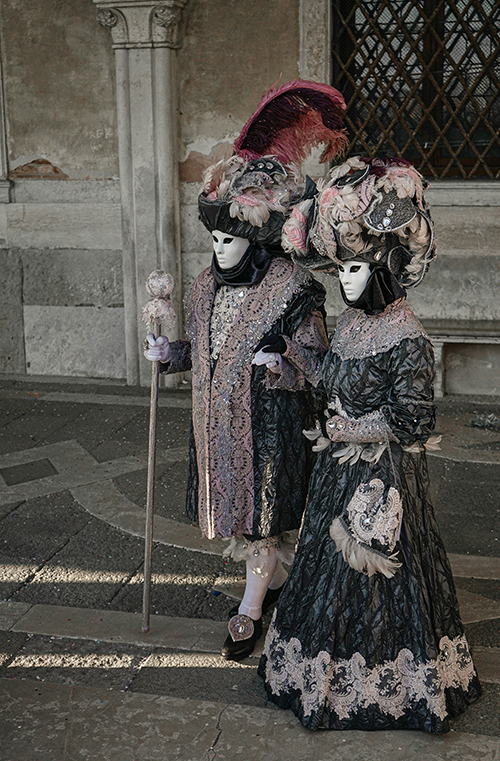
This year’s carnival runs from February 14th to March 4th, with various events taking place daily. Each year, a new theme is chosen and events are organized around that theme. The program and dates vary according to the religious calendar, as they precede the Easter holiday. Generally, it takes place between January, February, and March, but to keep track of the dates and events each year, it’s important to visit the carnival’s official website.
This year’s theme is “The Time of Casanova .” Giacomo Girolamo Casanova, the Venetian who gave his name to the flirtatious act! While he’s often described as the world’s first certified flirflirt’s actually the 300th anniversary of the birth of a multi-talented figure who was a poet, writer, politician, soldier, diplomat, and a master of public speaking and a keen eye for women. Naturally, it makes one think this year’s events will be entertaining.
Highlights of the Venice Carnival
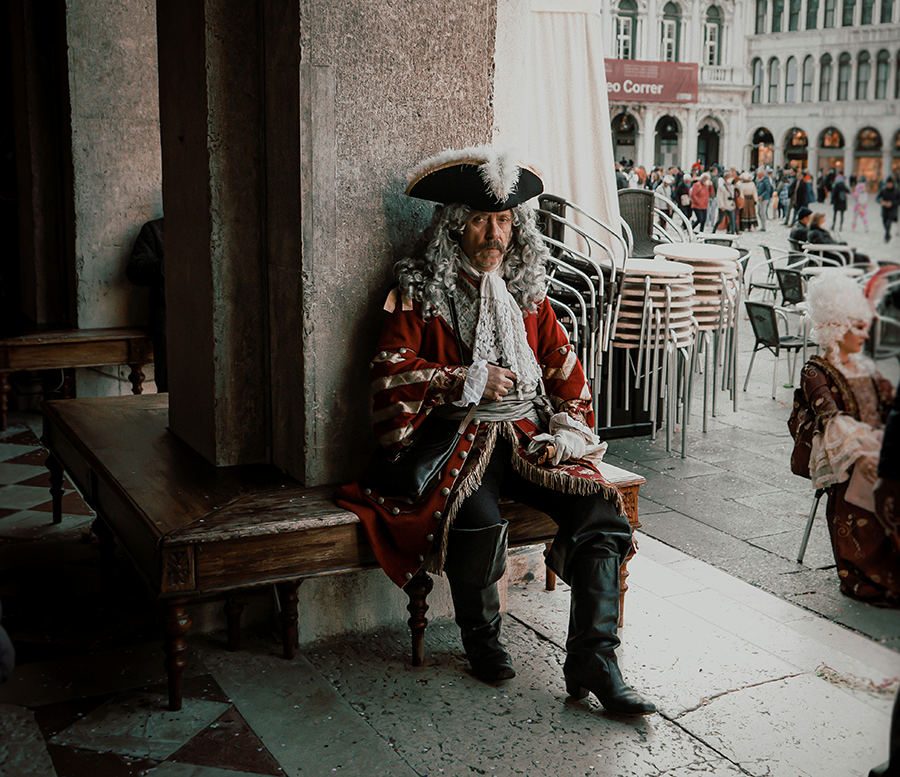
In the mid-1500s, an acrobat stretched a rope from his boat to the bell tower in front of the Doge’s Palace and, using a balance, walked along it without falling. The Venetians were so impressed that they began incorporating this magnificent event into the carnival as the ” Svolo del Turco ” (Flight of the Turk). It continued with greater pomp and circumstance, taking on different forms over the years. One day, an unfortunate accident caused the flight to be renamed the Flight of the Angel (Il Volo dell’Angelo). Now, every year, the unmarried woman who wins the Festa Delle Marie becomes the next year’s flying angel.
The official opening night of the carnival takes place in Rio del Cannaregio. Different events are then scheduled for each day. However, the real carnival takes place during the weekend of the Festa Delle Marie and the Flight of the Angel. The wildest days are the last Thursday before Lent, known as Giovedi Grasso and Martedi Grasso, and the final Tuesday, the day the carnival ends.
The Unwritten Rules of the Venice Carnival
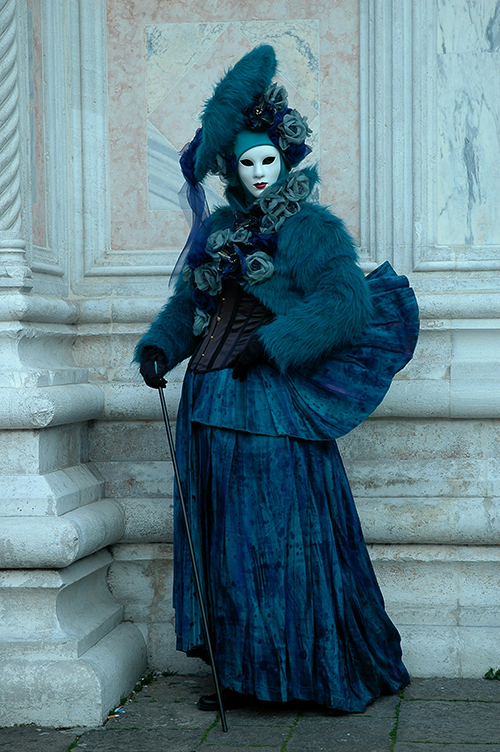
Carnival ( Il Carnavale ) actually comes from the Latin word Carnem Levare, meaning “to give up meat.” Carnival is also a time of eating and revelry before the fast. Literally meaning “Fat Thursday,” it remains so because it coincides with the celebrations following a victory won during the reign of Giovedi Grasso, and because of the slaughter of animals and the consumption of fatty foods. The name “Martedi Grassoise” derives from the consumption of fatty foods and sweets on the last day before the fast. It is believed to be derived from the French Mardi Gras.
Masks are essential for secrecy. Gender, race, and status are hidden beneath them. Besides all the entertainment, carnival is also an art form. The venue, music, costumes, and masks can fascinate us as traditional aesthetics. Therefore, throughout the carnival, the most beautiful costume and mask competitions are held twice a day on the platform set up in St. Mark’s Square. One in the morning and one in the afternoon.
Last weekend was also very busy, especially with the people of Veneto and Venice having fun by throwing parties around the Arsenale and Rialto.
Almost every morning, very early, sometimes even at sunrise, photographers and costume enthusiasts gather around St. Mark’s Square and in front of the Doge’s Palace to prepare for photos. You can even have a photo taken with a costumed character of your choosing, just by smiling. They love it.
A masked ball that will make you forget what year it is! Ca’ Vendramin Calergi, overlooking the Grand Canal, will hold its official ball this year on February 22nd, 23rd, 27th, 28th, and March 1st, 2nd, and 3rd. Masked and costumed, and expensive tickets are required. Costume rental workshops are listed in the recommendations section of the website.
In the Arsenale, the prestigious biennial exhibition is briefly replaced by a carnival of lights.
The Ca’Rezzonico Museum is a great choice for exploring one of the magnificent Venetian palaces, as well as the famous carnival artifacts. (Other alternatives include Casa di Carlo Goldoni, Museo Mocenigo, Palazzo Fortuny, and Museo Correr.)
Attending a mask workshop, whether with family or friends, can be a lot of fun. Mask-making in different parts of the city, with varying budgets, will be an unforgettable experience.
Hotel Danieli and Cafe Florian are places where you can transport yourself to another era without attending a masquerade ball. The experience will leave you fascinated for a long time.
The most surprising aspect of the carnival is coming across groups of masked and costumed friends in an unexpected side street or square.
Unfortunately, considering the dense crowds and the increased risk of pickpocketing, it may be a safer option to avoid carrying valuables and travel with a small zippered bag.
Venice Carnival Desserts
Delicious desserts are made specifically for Carnival. The most popular are frittelle and galani. Resembling a lokma dessert, frittelle, a type of fried dough filled with various ingredients such as currants, almonds, cream (including zabaione, a traditional cream unique to Venice), pine nuts, and whipped cream, are very common.
Venice Carnival Masks
One of the most talked-about items, with varying stories told, is, of course, masks. The most common is that during the first plague outbreak, doctors wore long-nosed masks to prevent infection from their patients. Another common story is that masks were worn by people whose faces were covered in plague scars. It’s believed to have become widespread because they concealed their identities. A significant number believe they became a form of entertainment, allowing wealthy and noble people, in particular, to move about freely for a period of time each year.
There are 16 common mask styles, each consisting of eight masks, divided into two main categories: commedia dell’arte (comedy) and carnevale (carnival). The most common masks during carnival include the Medico della peste (plague doctor), the Colombina (a mask believed to enhance the face), the Jester (a medieval clown), and Pulcinella, the lazy and idle servant, symbols of Naples.
What to Watch Out for at the Venice Carnival?
Based on counts based primarily on reservations and tickets, nearly 1 million people visit Venice during Carnival alone. The busiest days are weekends, Giovedi Gras, and Martedi Gras. Just imagine, on the day of the Angel’s Flight alone, an average of at least 115,000-150,000 tourists arrive each year. Therefore, it’s advisable to check your planned Carnival dates, purchase plane and train tickets well in advance, and book hotel reservations, as well as tickets for special Carnival balls, dinners, concerts, and theater events, as early as possible. If you want a clear view of the shows, it’s also a good idea to be in the square at least an hour before the event begins, bringing snacks and water, of course.
Venice Biennale
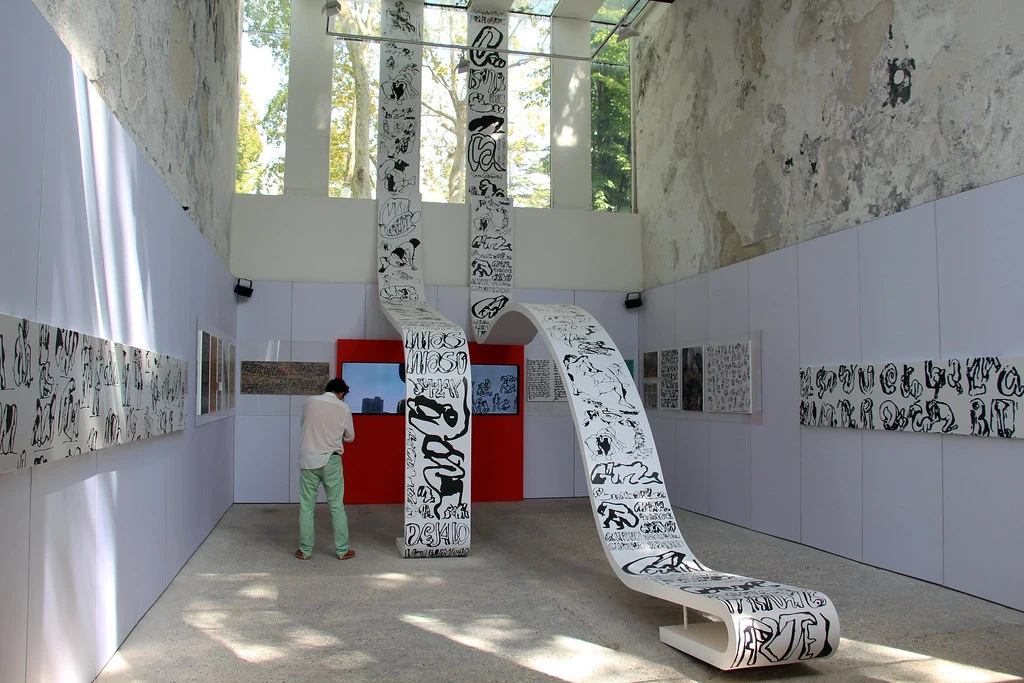
Founded in 1895 and considered one of the world’s most prestigious and distinguished cultural institutions, the Venice Biennale holds biennial exhibitions: one year for art and the other for architecture. The biennale, which typically runs from April to November, also features dance, music, theater, and film events.

